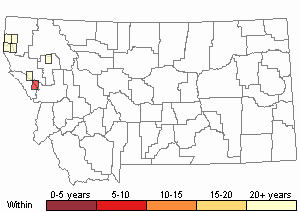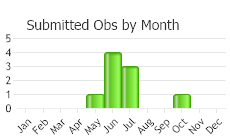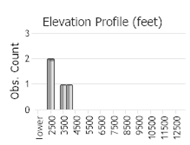View in other NatureServe Network Field Guides
NatureServe
Montana
Utah
Wyoming
Idaho
Wisconsin
British Columbia
South Carolina
Yukon
California
New York
Giant Golden Moss - Homalothecium megaptilum
Other Names:
Trachybryum megaptilum
State Rank Reason (see State Rank above)
Endemic to western North America. In Montana it occurs on the eastern edge of its distribution.
General Description
Plant: Pleurocarpous. Large, scattered individuals to loose mats. Glossy, yellow-green to brown below. Stems 6.0-15.0 cm long and branches 1-3 cm long. Main stem occasionally is regularly pinnate with branches in one plane.
Leaf: Stem leaves: Triangular-ovate to broadly ovate-lanceolate, 3-5 x 1.5-2.0 mm, auriculate, and acuminate to filiform at the apex. Branch leaves: Ovate-lanceolate, 1.7-2.5 x 0.8-1.0, broad & blunt integrating to narrow & filiform at the apex, not auriculate, and deeply plicate with many folds. Margins recurved from near base to apex or partially plain. Apex entire to serrate. Costa strong at base, tapering towards apex, about 2/3 or more length of leaf, and often ends in a spine.
Leaf Cells: Basal cells in a few rows, shorter than median cells (25-35 x 8-10 µm), and strongly pitted. Median cells long and narrow (60-100 x 5-6 µm). Alar cells similar to basal cells and extend up along margins.
Phenology
Capsules ripen in the summer.
Diagnostic Characteristics
The large size, typically very pale green color, and its orderly pinnate branching in one plane when moist make this species distinctive (FNA 2014).
Range Comments
Canada: BC; USA: CA, ID, MT, OR, WA (FNA 2014). In Montana, known from Lake, Lincoln, and Sanders Counties (Elliott 2016).
Observations in Montana Natural Heritage Program Database
Number of Observations: 10
(Click on the following maps and charts to see full sized version)
Map Help and Descriptions
Relative Density

Recency



 (Observations spanning multiple months or years are excluded from time charts)
(Observations spanning multiple months or years are excluded from time charts)
Habitat
Litter, rock, soil, and humus in coniferous forests (Elliott 2016), and on soil over rock in areas influenced by a Pacific maritime climate. Rare below 1,080 feet. Usually between 1,080-4,300 feet elevation.
Reproductive Characteristics
Dioicous, or phyllodiocous, in which very small males grow on the leaves of the female plants. Seta 2-2.5 cm tall and rough. Capsules inclined to horizontal, zygomorphic, short and thick, 2-2.5 mm, and contracted under the mouth when dry.
Stewardship Responsibility
References
- Literature Cited AboveLegend:
 View Online Publication
View Online Publication Elliott, J.C. and A.K. Pipp. 2018. A Checklist of Montana Mosses (1880-2018). Updated 3 January, 2020. Montana Natural Heritage Program, Helena, Montana. 73 pp.
Elliott, J.C. and A.K. Pipp. 2018. A Checklist of Montana Mosses (1880-2018). Updated 3 January, 2020. Montana Natural Heritage Program, Helena, Montana. 73 pp. Flora of North America Editorial Committee, eds. 2014. Flora of North America North of Mexico. Volume 28. Bryophytes: Mosses, Part 2. Oxford University Press, Inc., NY. xxi + 702 pp.
Flora of North America Editorial Committee, eds. 2014. Flora of North America North of Mexico. Volume 28. Bryophytes: Mosses, Part 2. Oxford University Press, Inc., NY. xxi + 702 pp.
- Additional ReferencesLegend:
 View Online Publication
View Online Publication
Do you know of a citation we're missing? Elliot, J. C. 1993. Second checklist of Montana mosses. Unpublished report. U.S. Forest Service, Region 1. Missoula, MT. 45 pp.
Elliot, J. C. 1993. Second checklist of Montana mosses. Unpublished report. U.S. Forest Service, Region 1. Missoula, MT. 45 pp. Lawton, E. 1971. Keys for the Identification of the Mosses on the Pacific Northwest. Reprinted from 'Moss Flora of the Pacific Northwest'. Published as Supplement No. 2 of the Journal of the Hattori Botanical Laboratory. Nichinan, Miyazaki, Japan. 66 pp.
Lawton, E. 1971. Keys for the Identification of the Mosses on the Pacific Northwest. Reprinted from 'Moss Flora of the Pacific Northwest'. Published as Supplement No. 2 of the Journal of the Hattori Botanical Laboratory. Nichinan, Miyazaki, Japan. 66 pp. Lawton, E. 1971. Moss Flora of the Pacific Northwest. Hattori Botanical Laboratory. Japan: Yamabuki-cho, Shinjuku-ku, Tokyo. 362 pages plus appendices.
Lawton, E. 1971. Moss Flora of the Pacific Northwest. Hattori Botanical Laboratory. Japan: Yamabuki-cho, Shinjuku-ku, Tokyo. 362 pages plus appendices.
- Web Search Engines for Articles on "Giant Golden Moss"





